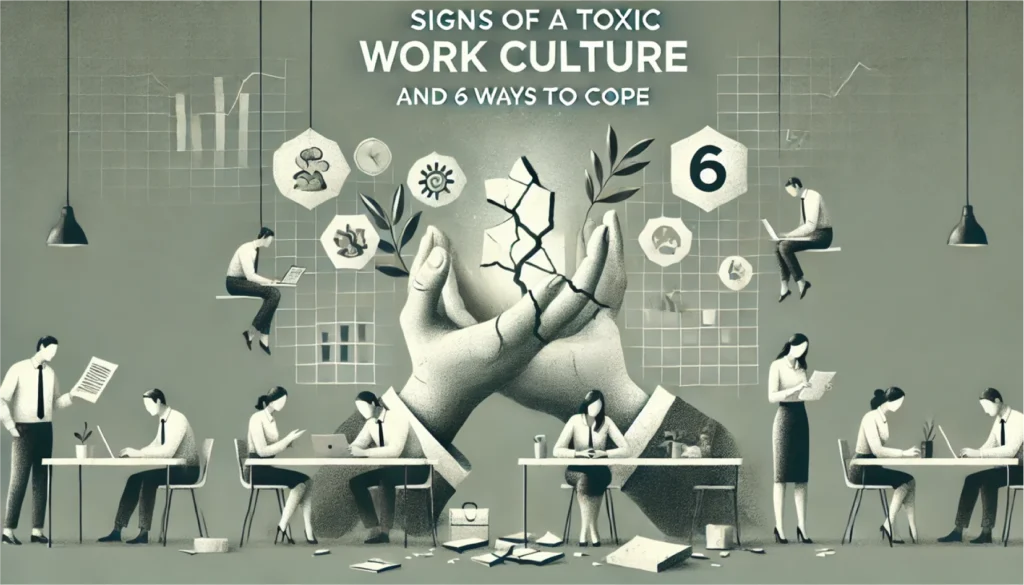Signs of a Toxic Work Culture and 6 Ways to Cope

Toxic work culture—it’s a phrase that’s thrown around often, but what does it truly mean? In essence, a toxic work culture refers to a workplace environment rife with negativity, dysfunction, and stress. This isn’t just the occasional bad day at the office; it’s a pervasive atmosphere that impacts employees’ morale, productivity, and overall well-being.
Unfortunately, toxic work environments are alarmingly common. Studies have shown that over 70% of employees have encountered toxic behaviors at work, whether it’s micromanagement, favoritism, or bullying. If left unchecked, these conditions can lead to high turnover rates, health issues, and even business losses.
Understanding and addressing workplace toxicity is crucial—not just for employees but for organizations. Identifying the warning signs and adopting coping strategies can empower you to regain control of your professional life. In this article, we’ll explore the signs of a toxic work culture and share six effective ways to cope with it.

Characteristics of a Toxic Work Environment
Defining Toxic Work Culture
A toxic work culture is characterized by behaviors and attitudes that create a hostile or unhealthy atmosphere. This can include:
- Poor communication: Team members or managers fail to communicate effectively, leading to misunderstandings and frustration.
- Favoritism: Certain employees receive unfair advantages, undermining team cohesion.
- Lack of boundaries: Employees are expected to be available 24/7, eroding personal time.
These behaviors can drain employees’ motivation, making even the most passionate workers dread coming to the office.
How Common is Toxic Work Culture?
The prevalence of toxic workplaces is shocking. According to recent surveys:
- Over 60% of employees report experiencing unhealthy work dynamics.
- Companies with toxic cultures have higher turnover rates—up to 50% more than those with supportive environments.
Clearly, this isn’t a niche issue. Toxicity in the workplace affects industries across the board, making it essential to recognize and combat its presence.
Key Signs of a Toxic Work Culture
How can you tell if your workplace is toxic? Here are some red flags:
1. Micromanagement: If you constantly feel your work is under a microscope, it’s a sign of a lack of trust.
2. Frequent Gossip and Cliques: Office drama or exclusionary behavior erodes morale.
3. High Turnover Rates: When employees frequently leave, it’s often due to dissatisfaction.
4. Unrealistic Demands: Constantly working overtime or being expected to deliver impossible results can burn out even the most capable professionals.
Recognizing these patterns early can help you take proactive steps to address the situation or protect your mental health.
Psychological and Physical Impact in Toxic Work Culture
Toxic workplaces don’t just hurt your career—they can wreak havoc on your health. Employees trapped in such environments often face:
- Stress and Anxiety: Constant pressure can make even routine tasks feel overwhelming.
- Burnout: Exhaustion and lack of motivation are common outcomes.
- Physical Health Issues: Chronic stress can lead to headaches, digestive problems, and even heart disease.
It’s not just the individual who suffers; businesses experience reduced productivity, higher absenteeism, and potential reputational damage when toxicity is allowed to fester.
6 Ways to Cope with a Toxic Work Culture
1. Set Personal Boundaries
Start by defining what’s acceptable for you. Are you being asked to work late regularly? Politely but firmly decline tasks that infringe on your personal time. Creating boundaries helps preserve your energy and mental health.
2. Build a Support Network
Having allies at work can provide much-needed relief. Whether it’s a trusted colleague or a manager willing to listen, a support system can make a world of difference.
3. Document Toxic Incidents
If you’re dealing with toxic behaviors such as harassment, bullying, or unreasonable demands, start keeping a detailed record of these occurrences. Include:
- Dates and times.
- A description of the incident.
- Individuals involved and witnesses, if any.
Documentation is crucial if you decide to escalate the issue to HR or take legal action. It also helps you reflect on patterns of behavior that might otherwise seem isolated.
4. Communicate Assertively
Speaking up might seem daunting, but clear and assertive communication can sometimes defuse a toxic situation. When addressing concerns:
- Focus on facts, not emotions.
- Use “I” statements (e.g., “I feel overwhelmed by these deadlines”) to avoid sounding accusatory.
- Suggest solutions or compromises.
This approach demonstrates professionalism and can help shift the conversation toward resolution.
5. Seek Professional Help
If the toxicity is taking a toll on your mental health, don’t hesitate to consult a therapist or counselor. These professionals can provide tools to manage stress, build resilience, and maintain a positive mindset even in challenging circumstances.
Workplace coaching or career counseling can also help you evaluate your options and create a plan to navigate or exit the toxic environment.
6. Explore Exit Strategies
Sometimes, the only way to truly cope is to leave. Begin by assessing your financial stability and career goals. Then:
- Update your resume and LinkedIn profile.
- Start networking with industry peers.
- Apply for roles that align with your values and priorities.
Quitting a toxic job might feel intimidating, but your mental and physical health should always come first. Remember, leaving isn’t giving up—it’s choosing to prioritize your well-being.

The Role of Leadership in Combating Toxicity
Workplace toxicity isn’t just an employee problem—it’s a leadership challenge. Effective leaders can prevent and address toxicity through:
1. Open Communication Channels
Creating a culture where employees feel safe sharing concerns is key. Regular feedback sessions and anonymous surveys can help leaders identify and address issues early.
2. Training Managers to Recognize Toxic Behaviors
Leaders often set the tone for workplace dynamics. Training programs can help them:
- Spot signs of toxicity.
- Manage conflicts constructively.
- Promote inclusivity and fairness.
3. Enforcing Zero-Tolerance Policies
Implementing strict policies against bullying, harassment, and discrimination sends a clear message that toxic behaviors won’t be tolerated.
Leadership must walk the talk—if employees see managers addressing issues transparently, they’re more likely to trust the system.

4. Rewarding Positive Behaviors
Incentivizing collaboration, kindness, and teamwork can gradually shift the workplace culture toward positivity. Public recognition and rewards for supportive behaviors encourage others to follow suit.
A toxic work culture can feel like a storm cloud hanging over your career, but it doesn’t have to define your professional life. By recognizing the signs, understanding the impacts, and implementing coping strategies, you can protect your mental and physical health. Additionally, organizations can combat toxicity by fostering open communication and empowering leaders to lead by example.
Ultimately, no job is worth sacrificing your well-being. Whether you choose to address the issues head-on or explore new opportunities, remember: you have the power to reclaim your work-life happiness.

